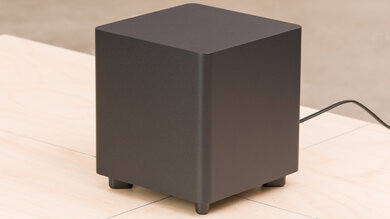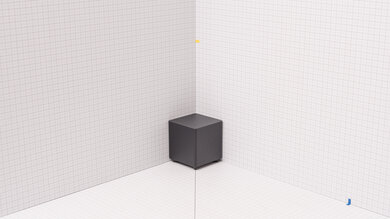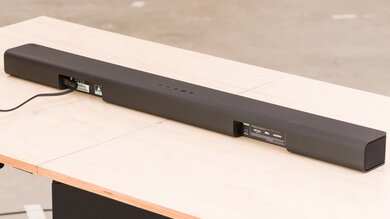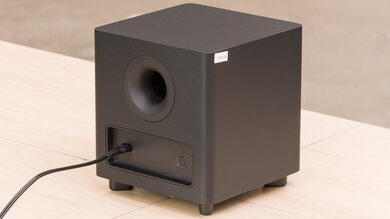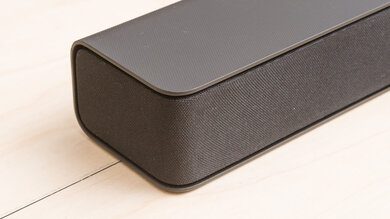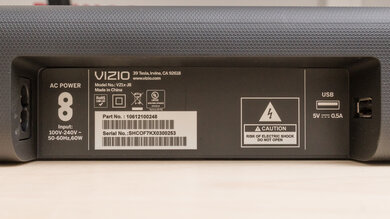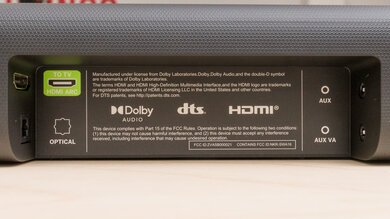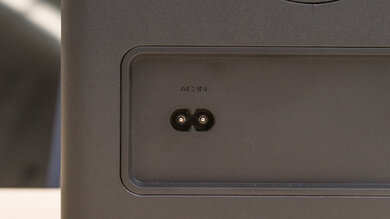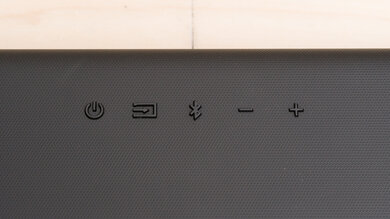The Vizio V Series V21x-J8 is a budget-friendly 2.1 setup released in 2021. This soundbar has a bass-heavy sound profile that adds extra punch and boom to your audio, though vocals and lead instruments are still mostly reproduced clearly and with detail. It comes with a few EQ presets so you can customize its sound, but it lacks more premium sound enhancement features. It also doesn't support Dolby Atmos or DTS:X content.
Our Verdict
The Vizio V Series 2.1 Sound Bar is fair for mixed usage. This 2.1 soundbar has a bass-heavy sound profile that adds extra punch to your audio, but you can use its bass and treble adjustments to get a more neutral sound if you prefer. Its mostly balanced mid-range can still reproduce dialogue clearly, which is handy for TV fans. However, it has a poor surround performance, and it doesn't support Dolby Atmos content.
-
Bass and treble adjustments.
-
Dialogue enhancement feature.
-
Poor surround performance.
-
No height channels.
The Vizio V Series 2.1 Sound Bar is satisfactory for dialogue-centric content like TV shows. Its mostly balanced mid-range reproduces voices clearly and with detail. There's also a dialogue enhancement feature that can make voices more crisp and clear. However, it lacks a discrete center channel, so voices seem to come from a more general area rather than a pinpoint location.
-
Dialogue enhancement feature.
-
Bluetooth-compatible.
-
Disappointing center channel performance.
-
No support for Wi-Fi, Chromecast built-in, Apple AirPlay.
The Vizio V Series 2.1 Sound Bar is decent for music. On its 'Music' preset, it has a bass-heavy sound profile that adds extra emphasis in the bass range. However, voices and lead instruments are still mostly reproduced clearly. You can also use its EQ presets and its bass and treble adjustments to get a more neutral sound, if you prefer. While the bar gets pretty loud, unfortunately, there's some compression present at max volume.
-
Gets loud.
-
Bass and treble adjustments.
-
Compression at max volume.
-
No graphic EQ.
The Vizio V Series 2.1 Sound Bar is acceptable for movies. Its bass-heavy sound profile helps you feel the deep rumble and punch in action-packed movie scenes, and dialogue mostly reproduces clearly. It supports surround content, but unfortunately, it has to downmix it to stereo to play it. Also, it doesn't support object-based audio formats like Dolby Atmos or DTS:X.
-
Gets loud.
-
Bass and treble adjustments.
-
Poor surround performance.
-
No height channels.
- 6.8 Mixed Usage
- 7.4 Dialogue/TV Shows
- 7.1 Music
- 6.2 Movies
Changelog
- Updated Oct 20, 2022: Added a market comparison with the Vizio V Series V214x-K6 to the 'Bar - Dimensions' box.
- Updated Jul 21, 2021: Review published.
- Updated Jul 16, 2021: Early access published.
- Updated Jun 21, 2021: Our testers have started testing this product.
- Updated Jun 21, 2021: The product has arrived in our lab, and our testers will start evaluating it soon.
Check Price
Differences Between Sizes And Variants
The Vizio V Series 2.1 Sound Bar comes in Black, and you can see the label for the model we tested here.
If you come across another version of this soundbar, let us know in the discussions, and we'll update our review.
Compared To Other Soundbars
The Vizio V Series 2.1 Sound Bar is a budget-friendly setup, and is the next generation of the Vizio V Series V21-H8. Unlike its predecessor, it has an AUX In port that lets you plug in third-party voice assistant devices to control the bar. Its bass-heavy sound profile adds extra boom and punch to your audio, and it also comes with some sound customization features.
See our recommendations for the best budget soundbars, the best soundbars under $300, and the best Vizio soundbars.
The Vizio V Series V21-H8 is a better soundbar for mixed usage than the Vizio V Series V21x-J8. The V21-H8 has a slightly more balanced sound profile out-of-the-box, and it gets louder with less compression at max volume. Also, it has a better center channel performance. That said, the V21x-J8 has an AUX In port for third-party voice assistant devices, and its sub is a bit smaller.
The 5.1 Vizio V Series V51-H6 is a better soundbar than the 2.1 Vizio V Series V21x-J8. The V51-H6 gets louder, and it has better center and surround performances. Also, some listeners may prefer its more neutral out-of-the-box sound compared to the V21x-J8's more bass-heavy sound profile.
The standalone Sonos Arc is a better soundbar than the Vizio V Series V21x-J8. The Sonos is a 5.0.2 setup that's better built and, unlike the Vizio, supports Dolby Atmos content. It also has better soundstage, center, and surround performances and has a room correction feature. Some listeners may prefer its more neutral default sound profile to the Vizio's bass-heavy sound. The 2.1 Vizio comes with EQ presets, unlike the Sonos.
The Samsung HW-A550 is a better soundbar than the Vizio V Series V21x-J8. The Samsung is better-built and has a more neutral default sound profile, which some listeners may prefer. Unlike the Vizio, it also comes with a graphic EQ for sound customization and a Full HDMI In port. That said, the Vizio offers a better surround performance.
The Yamaha YAS-209 is a slightly better soundbar for mixed usage than the Vizio V Series V21x-J8. The Yamaha offers a more neutral sound profile out-of-the-box, which some listeners may prefer. It also has a better center channel performance and more wireless playback options. Unlike the Vizio, it comes with built-in voice assistant support and a Full HDMI In port. However, the Vizio has some more sound enhancement features, including bass and treble adjustments and an auto-volume mode.
The Vizio V Series V21x-J8 is better than the Vizio M-Series M21d-H8R. The V Series comes with a dedicated sub that can reproduce a more extended low-bass. It also has a better soundstage performance, and far less compression when you play it at max volume. That said, the standalone M-Series is better suited if you don't have a lot of space in your room.
The Vizio V Series V51x-J6 is a better soundbar than the Vizio V Series V21x-J8. The V51x-J6 comes with discrete satellite speakers, so it offers better surround performance. It also has a more neutral sound profile and less compression at max volume. Thanks to its 5.1 setup, it has better center channel performance, too.
Depending on your listening habits, you may prefer either the Vizio V Series V21x-J8 or the Hisense HS218. The Vizio has a better stereo soundstage, and it reproduces a more extended low-bass. That said, the Hisense is better built, with a better center channel performance. Some listeners may prefer its more neutral default sound profile over the Vizio's more bass-heavy sound profile.
Depending on your listening habits, you may prefer either the Vizio V Series V21x-J8 or the Vizio V Series V214x-K6. They're both budget-friendly 2.1 soundbars with similar designs. The V214x-K6 has a more balanced sound profile out-of-the-box, and it's a bit smaller overall. Its smaller design means that its soundstage isn't quite as good as the V21x-J8, which also offers HDMI inputs.
The Vizio V Series V21x-J8 is better than the Creative Stage. The Vizio is a bit more expensive, but it's better built and can reproduce more low-bass. Plus, it comes with more sound enhancement features and support for more audio formats. It offers less compression and distortion, too.
Test Results
This soundbar has a simple, sleek design. It's mostly made of plastic, and there's fabric covering the front and the sides. It sits on four rubber feet. Overall, it looks very similar to the Vizio V Series V21-H8.
The Vizio V Series 2.1 Sound Bar is wide, but it should still fit between the legs of most 55-inch TV stands. It also isn't very tall, so it shouldn't obscure your TV screen unless your TV sits flush on your table. If you want a smaller bar, consider the Vizio V Series V214x-K6 instead.
The Vizio V Series 2.1 Sound Bar has a decent build quality. The bar is mostly plastic, which feels solid and durable. However, the fabric covering the front and the sides of the bar seems like it could rip or collect dust easily, which is disappointing. That said, the subwoofer's melamine build also seems sturdy. For a better built soundbar, check out the Hisense HS218.
The Vizio V Series 2.1 has a satisfactory stereo frequency response. On its 'Music' preset, it has a bass-heavy sound profile that adds extra punch and boom to your audio. That said, its mid-range is mostly balanced, so voices and lead instruments are mostly clear and detailed. There are also bass and treble adjustments and EQ presets to help you customize its sound.
The Vizio V Series 2.1 Sound Bar has a very good stereo frequency response with calibration. With its bass set to '-5' and its treble set to '1' and on its 'Music' preset, it offers a very neutral, balanced sound profile that's suitable for listening to lots of different types of audio content.
The Vizio V Series 2.1 Sound Bar has a decent stereo soundstage performance. Its soundstage is perceived to be a bit wider than the bar itself. Its focus is good, too, so sound objects like voices can be pinpointed to an accurate location, though it can also sound like a more general area is moving at times.
The Vizio V Series 2.1 Sound Bar has a fair stereo dynamics performance. It can get loud, which is handy for listeners who like to crank up the volume to fill up large spaces and crowded parties. However, there's compression at max volume, especially in the bass range.
The Vizio V Series 2.1 has a decent stereo THD performance. At normal listening volumes, it falls within good limits, resulting in clean and pure audio reproduction. There's a jump in THD when the bar is pushed to max volume. That said, THD can be hard to hear with real-life content, so you may not notice it.
The Vizio V Series 2.1 Sound Bar has a middling center channel performance. Due to its 2.1 configuration, it lacks a discrete center channel. Instead, it uses its left and right speakers to simulate a sound in the center. As a result, voices seem to come from a more general area rather than a pinpoint location.
The Vizio V Series 2.1 Sound Bar has a poor surrounds performance. It has to downmix surround content into stereo in order to play it. Unfortunately, this doesn't sound as clear or real as a setup with discrete surround speakers, like the Vizio V Series V51x-J6. Surround objects like voices and footsteps seem like they're coming from speakers placed in front of you rather than from all around you.
The Vizio V Series 2.1 Sound Bar has an okay selection of sound enhancement features. You can customize its sound using its bass and treble adjustments as well as its EQ presets: 'Movie', 'Music', 'Dialogue', and 'Game'. You can also use the TVOL button on the remote to activate the auto-volume mode, which balances the volume level across different programs. That said, it lacks more premium sound enhancement features like a graphic EQ or a room correction feature, so it may sound a bit different depending on the room you're listening in.
The Vizio V Series 2.1 comes with several physical inputs. There's an AUX port, so you can plug in older devices to the bar for audio playback. There's also a USB port so you can listen to music from a thumb drive.
Note: According to our testing methodology, we don't consider this soundbar to have an HDMI Out port. It doesn't have a Full HDMI In port, so users aren't able to plug in two HDMI devices at the same time.
The Vizio V Series 2.1 Sound Bar has good audio format support via ARC. It supports Dolby Digital, which is the most common surround sound format found on Blu-ray discs and streaming platforms. That said, it doesn't support eARC, so it doesn't support lossless or object-based formats like Dolby Atmos or DTS:X.
The Vizio V Series 2.1 Sound Bar supports both Dolby Digital and DTS content via Optical. You can commonly find these formats on Blu-ray discs and streaming platforms.
The Vizio V Series 2.1 Sound Bar has an impressive latency performance. It has fairly low latency via both ARC and Optical, so the audio you hear is mostly in sync with the video you see. As a result, it's suitable for watching videos over these connections. However, some apps and TVs can compensate for latency differently, so your experience may vary.
The Vizio V Series 2.1 only supports Bluetooth connectivity. You can wirelessly stream audio from your mobile devices to the bar over this connection, but you can't connect devices using Wi-Fi, Chromecast built-in, or Apple AirPlay.
The Vizio V Series 2.1 Sound Bar doesn't have a Full HDMI In port, so it doesn't support high-quality passthrough.
The Vizio V Series 2.1 has an AUX In port that lets you plug in voice assistant-enabled devices so you can control the bar with your voice. However, we don't consider this as built-in voice assistant support since it requires purchasing a third-party device.
The Vizio V Series 2.1 Sound Bar has an eco-power mode that automatically turns the bar off after a period of inactivity. However, this feature is turned off by default, according to the manual. It also has HDMI CEC support, so you can use your TV remote to control the bar's basic functions.
Comments
Vizio V Series V21x-J8: Main Discussion
Let us know why you want us to review the product here, or encourage others to vote for this product.



